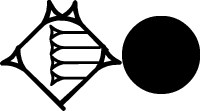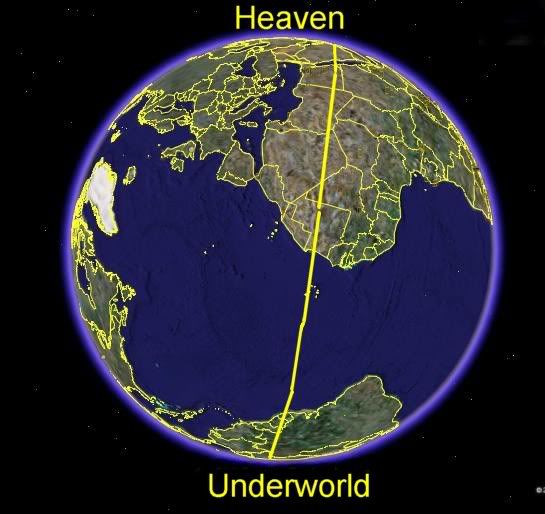This list is compiled from the contemporary accounts of the inhabitants of Mesopotamia themselves. Other attempts to fit certain of these Kings into timeframes has been done by either Radiocarbon dating artifacts or by chronological dating methods. In both cases this has led to very varied dates that usually differ by up to 300 years in either direction. Firstly because Radiocarbon dating is not very accurate to a certain year and secondly because chronological dating is innefective on an archaeological site where artifacts were used again and again by successive generations so that an artifact manufactured around 2500bce can be found in a layer dating to 2000bce. So therefore this list is compiled backwards using the length of stated rule of each ruler from very well established dates, in this case the foundation of the Babylonian Empire in 1894bce.
the reason for so much confusion for the dates on the original list is because it appears like this in its original format:-
40-94. After the flood had swept over, and the kingship had descended from heaven, the kingship was in Kiš. In Kiš, Ĝušur became king; he ruled for 1200 years. Kullassina-bēl ruled for {960} {(ms. P2+L2 has instead:) 900} years. Nanĝišlišma ruled for (ms. P2+L2 has:) {670} (?) years. En-taraḫ-ana ruled for (ms. P2+L2 has:) {420} years
no attempt has ever been made to ratify this messy way of annotating the kings of mesopotamia as for a long time it wasn't understood that the Sumerians used base 60 to annotate numerics which left them having reigns of an impossible amount of years such as "Ĝušur became king; he ruled for 1200 years." whereas when Sumerian power waned and semites became kings they used for them the more traditional base ten system which we still use today.
That the sumerians used 60 in this manner is irrefutable and you need only look at the face of a clock to see the truth of this as the system that we still use today to record time came from this very same ancient source.
This one small fact has changed the face of civilisation as we know it by leading to the fiction perpetrated in the old testament leading the Hebrews to claim that they too had mighty leaders who ruled for hundreds of years, such as Methuselah who reportedly reached an age of 969 years. In base 60 this means that he was in fact just over 16 years old at the time of his death.
This error was then in turn overlooked by Bishop James Usher when he compiled his biblical chronology to work out the total age of the earth believing it to be created in 4004bce in 6 days by a guy called simply God.
In addition it is probably worth mentioning here that there are 23 kings of Kish (Kiš) and 23 Biblical patriarchs. this is not a coincedence. It is in fact a very early form of plaguiarism.
As it turns out the god of Bishops Ushers faith was based on the Hebrew God YHWH, and now in turn it seem that the Hebrew God YHWH was based in part on the Mesopotamian god Enlil who was in fact based on a number of early ruling Kings who were fully human. In other words the name Enlil was an epithet which meant "high king". Ushers chronology was used to change the face of the world and the belief system of the more civilised members of society at that time. It held back advances in science which contradicted it and was used as a form of established racism to denegrate races who not knowing the word of the one true God were relegated to "conquered peoples" and exploited sometimes in a most horrible fashion.
so this is a list of high kings in the same way that the Egyptian king list only notates those believed to hold the spirit of Horus and in the same way that the ancient Irish used the term "Ard Rí na hÉireann" to seperate the King who was God from the simple feudal type vassal king who was not. This is supported by the fact that there are many Kings of Mesopotamia not mentioned on this list yet who are well established by archaeology to have controlled certain areas. Only in truly ancient times did this type of kingship flourish. No one would argue with a king who was God and this is the glue that held early civilisation together in the first place
the numbers after each Kings name are
Stated Length of rule: the number that appears on the list
Base 60 : the same number in base 60
Base 10 : the same number in base 10
Chronology : the date of the Kings succession
Race : the race of the king Su - Sumerian /Se - Semite
Kiš
Ĝušur 1200 1200 20 3592bce Su
Kullassina-bēl 960 960 16 3572bce Su
Nanĝišlišma 670 670 11 3556bce Su
En-tara-ana 420 420 7 3545bce Su
Babum 300 300 5 3538bce Su
Puannum 840 840 14 3533bce Su
Kalibum 960 960 16 3519bce Su
Kalūmum 900 900 15 3503bce Su
Zuqāqīp 900 900 15 3488bce Su
Atab 600 600 10 3473bce Su
Mašda 840 840 14 3463bce Su
Arwium 720 720 12 3449bce Su
Etana, the shepherd 1500 1500 25 3437bce Su
Bali 410 410 6 1/2 3412bce Su
En-me-nuna 660 660 11 3406bce Su
Melem-Kiš 900 900 15 3395bce Su
Barsal-nuna 1200 1200 20 3380bce Su
Zamug 140 140 2 1/3 3360bce Su
Tizqār 305 305 5 3357bce Su
Ilku 900 900 15 3352bce Su
Iltasadum 1200 1200 20 3327bce Su
En-me-barage-si 900 900 15 3307bce Su
Aga 625 625 10 1/2 3292bce Su
E-Ana
Meš-ki-aĝ-gašer 325 325 5 1/2 3281bce Su
Enmerkar 420 420 7 3275bce Su
Lugalbanda 1200 1200 20 3268bce Su
Dumuzid the fisherman 110 110 2 3248bce Su
Gilgamesh 126 126 2 3246bce Su
Ur-Nungal 30 1800 30 3244bce Se
Udul-kalama 15 900 15 3214bce Su
Lā-ba’šum 9 540 9 3199bce Su
En-nun-tara 8 480 8 3190bce Se
Meš-e 36 2160 36 3182bce Se
Urim
Meš-Ane-pada 80 80 1 1/3 3146bce Su
Meš-ki-aĝ-Nanna 36 36 7 months 3144bce Su
Elulu 25 25 5 months 3143bce Su
Balulu 36 36 7 months 3143bce Su
Awan
King 1 120 120 2 3142bce N/A
King 2 120 120 2 3140bce N/A
King 3 116 116 2 3138bce N/A
Kiš
Susuda, the fuller 201 201 3 1/3 3136bce Su
Dadasig 81 81 1 1/3 3135bce Su
Mamagal, the boatman 360 360 6 3134bce Su
Kalbum 195 195 3 1/3 3128bce Su
Tuge 360 360 6 3125bce Su
Men-nuna 180 180 3 3119bce Su
Lugalĝu 420 420 7 3116bce Su
Amazi
Hadaniš 360 360 6 3109bce Su
Unug
En-šag-kuš-ana 60 60 1 3103bce Su
Lugal-ure/Lugal-kiniše-dudu 120 120 2 3102bce Su
Argandea 7 420 7 3100bce Su
Urim
Nanni 54 3240 54 3093bce Se
Meš-ki-aĝ-Nanna 48 2880 48 3039bce Se
Unknown 2 120 2 2991bce Se
Adab
Lugal-Ane-mundu 90 90 1 1/2 2989bce Su
Mari
Anbu 30 90 30 2987bce Se
Anba 17 1020 17 2957bce Se
Bazi the leatherworker 30 1800 30 2940bce Se
Zizi the fuller 20 1200 20 2910bce Se
Limer, gudug priest 30 1800 30 2890bce Se
Šarrum-īter 9 540 9 2860bce Se
Kiš
Kug-Bau (fem) 100 100 1 1/2 2851bce Su
Akšak,
Unzi 30 1800 30 2849bce Se
Undalulu 12 720 12 2819bce Se
Urur 6 360 6 2807bce Se
Puzur-Nira 20 1200 20 2801bce Se
Išu-Il 24 1440 24 2781bce Se
Šu-Suen 24 1440 24 2757bce Se
Kiš,
PuzurSuen son kugbau 25 1500 25 2733bce Se
Ur-Zababa 400 400 6 1/2 2708bce Su
Unug
Lugal-zage-si 34 2040 34 2700bce Se
Agade
Sargon 56 3360 56 2666bce Se
Rimus 15 900 15 2610bce Se
Man-ištiššu 15 900 15 2595bce Se
Narām-Suen 56 3360 56 2580bce Se
Šar-kali-šarrī 25 1500 25 2524bce Se
Irgigi 1 60 1 2499bce Se
Imi 1 60 1 2498bce Se
Nanum 1 60 1 2497bce Se
Illulu 2 120 2 2496bce Se
Dudu 21 1260 21 2495bce Se
Šu-Durul 18 1080 18 2474bce Se
Unug
Ur-niĝin 30 1800 30 2456bce Se
Ur-gigir 15 900 15 2426bce Se
Kuda 6 360 6 2411bce Se
Puzur-ilī 20 1200 20 2405bce Se
Ur-Utu 25 1500 25 2385bce Se
Lugal-melem 7 420 7 2360bce Se
Gutium
No king 5 300 5 2353bce N/A
Inkišuš 7 420 7 2348bce Se
Zarlagab 7 420 7 2341bce Se
Inimabakeš 5 300 5 2334bce Se
Duga 6 360 6 2329bce Se
Igešauš 6 360 6 2323bce Se
Yarlagab 15 900 15 2317bce Se
Ibate 3 180 3 2302bce Se
Apilkin 3 180 3 2299bce Se
Lā-erabum 2 120 2 2296bce Se
Irarum 2 120 2 2294bce Se
Ibranum 1 60 1 2292bce Se
Ablum 2 120 2 2291bce Se
Puzur-Suen 7 420 7 2289bce Se
Yarlaganda 7 420 7 2282bce Se
Tirigan 40 days 10 40 days 2275bce Se
Unug
Utu-eĝal 427 7 7 2275bce Su
Urim
Ur-Namma 18 1080 18 2268bce Se
Šulgi, 58 3480 58 2250bce Se
Amar-Suena 25 1500 25 2192bce Se
Šu-Suen 9 540 9 2167bce Se
Ibbi-Suen 25 1500 25 2159bce Se
Isin
Išbi-Erra 33 1980 33 2134bce Se
Šu-ilīšu 20 1200 20 2101bce Se
Iddin-Dagan 25 1500 25 2081bce Se
Išme-Dagan 20 1200 20 2056bce Se
Lipit-Eštar 11 660 11 2036bce Se
Ur-Ninurta 28 1680 28 2025bce Se
Būr-Suen 21 1260 21 1997bce Se
Lipit-Enlil 5 300 5 1976bce Se
Erra-imitti 8 480 8 1971bce Se
Enlil-bāni 24 1440 24 1963bce Se
Zambiya 3 180 3 1939bce Se
Iter-piša 4 240 4 1936bce Se
Ur-du-kuga 4 240 4 1932bce Se
Suen-magir 11 660 11 1928bce Se
Damiq-ilišu 23 1380 23 1917bce Se
there are two very important characters in this list for those more biblically minded among you.
The first is Abraham and the second his only real son Ishmael.
Neither of them were from "Ur of the Chaldees" which didn't exist until a thousand years after the claimed death of Abraham in the Bible anyway and neither of them ever left their home on a quest instructed by god.
Basically because they were regarded as Gods in every sense of the word anyway and there are existing sumerian texts that illustrate this which I will post if anyone is interested of indeed if anyone can point out which two names on the list represent them
the list is compiled from three seperate king lists so is accurate in either direction to +/- 300 years.
in future I will be able to bring it down to +/- 50 years but I am very busy working on something else right now and thought some posters might like to see a preliminary rough version of this special chronology




